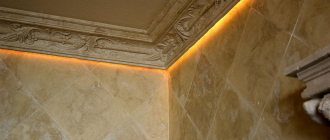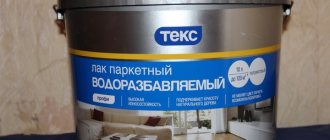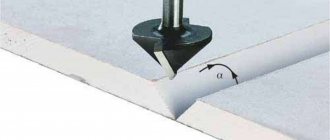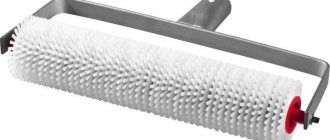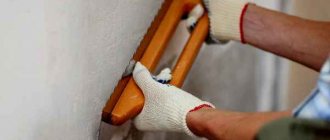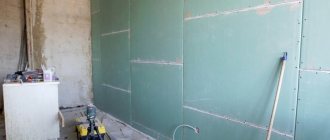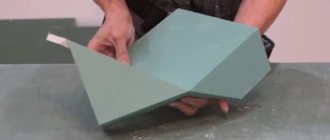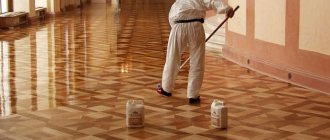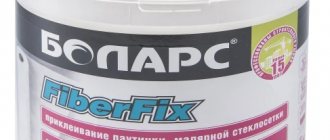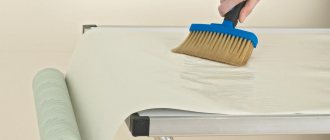No. 1. How to choose the color of the baseboard?
First, we pay attention not to the shape or material of the plinth, but to its color, so this parameter is always given the greatest importance. There are several approaches to choosing the color of the baseboard:
- to match the color of the flooring - the classic and most common method that allows the baseboard to merge with the floor. The likelihood of ruining the interior is reduced to a minimum, so this method is recommended for all those who are wary of bold, contrasting solutions. It is allowed to use skirting boards that are one or two shades lighter or darker than the floor covering. This option is great when the room uses solid boards, parquet, laminate or linoleum;
- match the color of the walls. This option is only possible if the walls are painted or plastered. one color. It is advisable to choose a plinth already when the coating has been applied and dried, otherwise you may not guess with the shade;
- match the color of the interior doors, but in this case the height of the plinth should be the same as the width of the door frames. Often this method is used when it is necessary to organically fit a door into the interior that does not match the color of the walls, furniture or floor. To make it look really good, you can make the color of the window frame, doors and baseboard the same;
- contrasting shade, which does not repeat the color of the flooring, the color of the walls, or the color of the doors. In order to correctly combine seemingly incompatible shades, you need to have a subtle sense of taste. You can take white skirting boards, which have recently been in high demand. Whatever it may be, it is still better to create a project for the future interior in advance in a special program and try different shades. There are very easy to use programs.
Criterias of choice
The color of skirting boards can be influenced by several criteria. The most significant are:
- Ceiling height. If the height of the walls is 270 cm or more, it is possible to install dark shades of both the baseboards themselves and the floor covering. In the case of low ceilings and a small room area, this can create a negative impression and create the visual effect of a cramped space. In this situation, it is more advisable to use light colors (light gray, golden, sunny).
- Choose the color of the baseboards and floors in harmony with the walls. In this case, it is important not to overdo it with shades.
- Creating a unified harmony due to the combined play of tones of other elements of the room.
Skirting boards for the attic floor Source remontum24.ru
No. 2. What can a floor plinth be made of?
The second most relevant and important issue when choosing a floor plinth is the question of the material used to make it. In this case, it is best to start from the flooring material:
- wooden plinth is suitable for floors made of block parquet and solid boards, parquet boards, laminate;
- MDF plinth and veneered plinth are suitable for parquet and laminate;
- PVC skirting boards are the cheapest and most popular option, often used with linoleum, tiles and carpet;
- ceramic baseboard Not so long ago it became available in a wide range and goes well with ceramic tiles.
Material selection
The appropriate material for skirting boards always depends on what the floor is made of. Wooden planks are combined with regular boards or other similar coverings. If you use a laminate of medium and minimal quality, MDF skirting boards or veneered planks are suitable.
For linoleum surfaces, MDF and PVC are suitable. You can install a plastic plinth with a specially attached insert, into which a fragment of the material used for covering the floor is inserted so that the color of the plinth matches. For ceramics, it is better to use the same ceramics or carefully selected plastic.
Wooden plinth
High-quality wooden skirting boards are made from natural solid wood:
- They are completely natural;
- Do not harm the environment;
- Easy to install;
- Cut to the appropriate length;
- Simply removed and repaired.
Among the many disadvantages, it is necessary to highlight the high sensitivity to changes in humidity levels, which implies some restrictions on the rooms where they can be used. Naturally, it is highly undesirable to install wooden baseboards in a bathroom.
Pine is considered the most common and budget option for wooden baseboards. Even high-quality products can be purchased for 2.25-3.25 USD. budget options cost about 0.75 USD. for 1 linear m.
Linden and oak are considered more expensive species. Other tree species are used much less frequently to create skirting boards. Exotic connoisseurs will pay special attention to planks made of ebony or mahogany, merabau, dusiya, etc.
When choosing wooden skirting boards, it is advisable to pay special attention to the properties of the wood. It is often possible to choose oak or aspen plinths for relatively little money. This low cost is due to the fact that the product is made of wood, which is glued together in several layers along the texture. Often the reason for the markdown can be a defective defect, or too many knots.
Veneer and MDF
Such strips are most often used for edging carpet surfaces. At the same time, walls are also often covered with MDF panels. Such products are made from compressed wood fibers and adhesive materials. MDF skirting boards are resistant to dirt, water and do not fade under sunlight. Prices vary from 2 to 3 USD.
MDF planks are fixed to the walls in the same way as wood products. For this you can use glue, as well as clasps. Hooks and staples are fixed on the wall; skirting boards must be placed on them with high density. Plastic plugs are placed at the corners and end cuts. Fixing with brackets makes it possible to dismantle the plinth and reuse it without any damage.
Veneered skirting boards belong to the category of wooden ones, but are not made from solid wood. Spruce or pine is used as a base, and veneer of more expensive species is used for coating. The shade can be selected to suit almost any taste. The cost of veneered skirting boards always depends on the material and varies in the range of 4.5-5.5 USD.
Until recently, it was difficult to install wiring in wooden baseboards. But today, skirting boards are made with a special channel.
No. 3. Wooden plinth: pros and cons
Despite the emergence of many new materials that captivate with their high performance qualities, wood remains at the top of its popularity. In addition, it is difficult to imagine that a wooden floor would be decorated with a baseboard made of non-natural material. Wood is valued due to its many advantages:
- durability;
- environmental friendliness;
- strength;
- excellent appearance;
- ease of installation.
Flaws:
- high price;
- sensitivity to temperature changes and high humidity, which imposes restrictions on the scope of use of the material (it is not suitable for kitchens and baths, but solid wood is used there extremely rarely).
Installation of wooden baseboards is usually carried out using self-tapping screws with flat heads; sometimes screws with dowels are used. The tree is easily cut at any angle, easily attached to the base and removed, and can be repaired. It is important that the wall is perfectly flat, otherwise the wood will quickly deform, and there will be no need to talk about any aesthetic appearance. It is also not recommended to use liquid nails for installation: if the humidity changes, internal tension can be created in the wood, which will tear both the baseboard and part of the wall covering away from the wall.
The wooden plinth is chosen from the same species from which the floor finishing is made, and it is advisable to select the plinth at the same time as choosing the finishing material. As for wood species , pine is the cheapest, oak and linden are more expensive, ash, alder, teak, cherry, walnut, and birch are less commonly used. Fans of exotic and non-standard solutions can turn their attention to merbau or dusiya wood. If the plinth is suspiciously cheap , pay attention to its quality: some manufacturers offer products glued together from three longitudinal layers of wood.
The cross-section of a wooden plinth can be different, as well as its shape and width. Today it is even possible to make custom-made skirting boards , if it is necessary that they accurately follow the curves and other complex areas of the room, but this is an expensive pleasure.
If you plan to open the baseboard with varnish or wax, remember that the wood may change color. To roughly understand what the result will be, you can wet a part of the surface of the untreated baseboard with a sponge.
History of skirting boards
No one knows exactly where this decorative element came from, but what is certain is that it was a very long time ago (thousands of years ago). Previously, they were used to prevent cold air from entering the house, and even then many tried to decorate these boards by cutting out patterns. Around the 16th century, when people acquired special machines, they were able to reach a new level of production and began making skirting boards from a variety of wood species.
At the beginning of the 18th century in France, plinth became a luxury item. It was made from ivory, tortoiseshell, copper and other exotic materials, but these are all relics of the past and now people began to use more modest materials.
No. 4. Veneered plinth
Veneered plinth has a structure similar to parquet boards. In it, only the top layer is made of valuable wood (walnut, oak, bamboo, pear, etc.), and the base is made of pine or spruce wood. The advantages and disadvantages are the same as those of a purely wooden baseboard, but the price is slightly lower . The shade and texture of the surface can be anything you want. By the way, today veneered and wooden plinths are equipped with a cable channel for laying electrical wires.
What types of wood are plinths made from?
Coniferous trees (pine, spruce, larch, fir) have greater moisture resistance and are not subject to deformation when the humidity in the room changes. These breeds are easy to process.
Hardwoods such as oak, maple and hornbeam are considered more “noble”. However, they are quite difficult to process and have a significant drawback - dry air leads to cracks in the product.
Profiles made of soft hardwoods (cherry, walnut, linden) look beautiful, but high air humidity is “contraindicated” for them.
Advice. Treatment of decorative solid wood profiles with specially developed compounds protects the baseboard well when the humidity conditions in the room change.
Products made from exotic tree species are also offered for sale. Mention may be made of rosewood, wenge, merbau, jatobe and ipe.
A separate group is veneered profile. Inexpensive wood is used as the basis for its manufacture (usually pine is used). which is then covered with veneer of expensive wood species. The veneer is protected with a layer of varnish or melamine. This product has an affordable price, has increased moisture resistance and a beautiful appearance.
No. 5. MDF plinth
A plinth made of MDF is the golden mean in terms of price and quality . In terms of properties, the material is almost as good as wood, and in some respects it even surpasses it, and at the same time it costs much less. MDF boards are made from sawdust, which is pressed under high temperature and pressure along with urea resins. The result is a durable and non-hazardous material that does not emit harmful substances into the air. The top of the board can be painted, laminated with a film or veneered with a thin layer of natural wood, so the appearance is very varied.
Advantages:
- resistance to moisture and temperature changes;
- UV resistance;
- antistatic;
- ease of installation and maintenance;
- relatively low price.
Flaws:
- strength and mechanical resistance are much lower than that of wood, but higher than that of plastic.
Experts say that MDF skirting boards can be attached to liquid nails, but it is better to use special clamps that are screwed to the wall. Due to this fastening, the plinth can be removed and reused. The slight flexibility of the material allows it to be attached to slightly curved walls.
LDF skirting boards on store shelves . LDF board is manufactured using the same technology as MDF, but has a lower density: 450-650 kg/cm3 for LDF versus 650-850 kg/cm3 for MDF.
Types of skirting boards: ranking of the best
| Photo | Name | Rating | Price | |
| #1 | Plastic skirting board | ⭐ 4.95 / 5 24 - votes | Find out the price | |
| #2 | MDF plinth | ⭐ 4.9 / 5 44 - votes | Find out the price | |
| #3 | Solid baseboard | ⭐ 4.85 / 5 7 — votes | Find out the price | |
| #4 | Polyurethane skirting board | ⭐ 4.8 / 5 33 - votes | Find out the price | |
| #5 | LDF skirting boards | ⭐ 4.75 / 5 17 — votes | Find out the price | |
| #6 | Tile plinth for the bathroom | ⭐ 4.7 / 5 10 — votes | Find out the price | |
| #7 | Metal skirting | ⭐ 4.65 / 5 8 — votes | Find out the price | |
| #8 | Cork plinth | ⭐ 4.6 / 5 1 - voice | Find out the price |
What would you choose or recommend?
Take the survey
On sale now you can find a variety of variations of skirting boards, which differ not only in color, size, but also in the material from which they are made. Depending on this, they have different recommendations for use, as well as appearance and a number of specific performance characteristics. Let's figure out what kind of skirting boards there are, depending on the material, and find out which option will be preferable in certain cases.
No. 1 - Plastic skirting board
Plastic skirting
The first place in our rating is unconditionally occupied by the ordinary plastic version. This is an inexpensive skirting board that is very practical and convenient, and it can also have almost any color and is often equipped with cable channels, inside of which it is convenient to lay wires. It is made from ordinary PVC.
This plinth consists of two parts - internal and external. During installation, the first one is fixed on the wall using self-tapping screws, and the second one is simply put on the first one. All joints, as well as the edges of the planks, are conveniently closed with special plugs, which are on sale wherever the plastic version of the plinth is sold. Installation is extremely simple and can be installed without outside help.
The color of the plastic version can be easily matched to both the color of the base coating and the material from which the doors are made. The price is very affordable, which allows you to include this option even on a very limited budget. The product, of course, has a drawback - it is fragile and not as durable as the same wooden one. It can be easily damaged by placing the chair poorly or hitting it during use. However, it still has many more advantages than disadvantages, which is why the majority choose it. For example, such a plinth can be installed even if the walls are not perfectly smooth.
On a note! A special plastic plinth is produced for carpeting, which allows you to fix the covering on the floor and at the same time disguise the plinth itself.
pros
- cheap
- large selection of colors
- doesn't rot
- not afraid of water
- can be installed in premises of any purpose
- not afraid of ultraviolet radiation
- there are often cable channels inside
- easy installation
- stores have ready-made components of the required size and color
- suitable for uneven walls
Minuses
- fragile
Prices for plastic skirting boards for floors
plastic skirting board for floor
No. 2 - MDF plinth
MDF plinth
This option is suitable for those who have flat walls, and it is relatively cheap, but at the same time durable and reliable. Optimal ratio of quality and cost. In terms of its parameters, it is almost as good as wood, and in some aspects it is even better than the latter, but it costs less.
This plinth is made from sawdust, which is pressed under pressure together with special resins. The result is a very strong and durable material. It is not hazardous to health if it is produced in compliance with all standards and requirements and does not become a source of harmful substances. The outside of each product is finished with veneer or laminated film or painted. Thanks to this, the color variations of MDF plinths are quite diverse. This option is ideally combined with parquet or parquet boards. By the way, just like a plastic baseboard, there may be cable channels inside.
It is a little more difficult to install than PVC skirting boards. It must be attached either to self-tapping screws that do not have heads, directly, or to special brackets.
The main disadvantage is that the outer coating of such a plinth is easily scratched. Overall, the product is very durable, but it can quickly lose its appearance if handled carelessly.
pros
- not afraid of moisture
- not afraid of temperature changes
- UV resistant
- relatively simple installation
- lasting
- antistatic
Minuses
- scratches easily
- not suitable for uneven walls
Prices for MDF plinths
MDF plinth for flooring
No. 3 - Solid baseboard
Solid baseboard
This option is created from solid wood. And it is considered the most environmentally friendly, since it is absolutely natural - there are not even any synthetic resins in the composition. This type of skirting board is ideal for children's rooms and bedrooms. Skirting boards are made from various types of wood, although literally 20 years ago only ordinary pine was available. Nowadays, stores offer products made from oak, ash, cherry and other species to suit every taste and budget.
Most often, such a plinth is chosen by people for whom the environmental friendliness of the material is important, as well as by those who lay parquet - the material combines perfectly. Installation is carried out using self-tapping screws or liquid nails. The main disadvantage is the need to tint and paint the baseboard in the desired shade. Also, this type tends to react strongly to changes in temperature or humidity levels - it should not be used in the bathroom or kitchen. But this is a durable option that will last for many years.
pros
- eco-friendly look
- high strength and reliability
- large selection of wood types
- beautiful view
- looks expensive
Minuses
- needs to be tinted
- Expensive
- afraid of humidity and temperature changes
- not suitable for curved walls
Prices for solid baseboards
wooden plinth for floor
Reviews of wooden skirting boards
No. 4 – Polyurethane skirting board
Polyurethane skirting board
This is the best option for those who have radius partitions or uneven walls in the room. Polyurethane plinth is flexible and suitable for framing non-standard shapes and curved planes.
This plinth is sold in the form of a long strip. Therefore, during installation, you can avoid the appearance of unnecessary joints of elements as much as possible. Looks great in combination with almost any type of flooring. They can have a beautiful relief pattern and different heights. Such a plinth is attached to a special profile pre-installed on the wall. Before fixing it, it needs to be heated in warm water - after cooling it will take the ideal desired shape.
It is important to remember that before installation, this plinth must be stored exclusively in its original packaging - when stored outdoors, it partially loses its properties. But this material can be painted in the desired color, it is safe and is not afraid of changes in environmental conditions. The service life declared by the manufacturers is about 30 years.
pros
- ideal for uneven walls
- may have different heights and textures
- easy to install
- helps prevent the formation of unnecessary joints
- can be painted in the desired color
- not afraid of changes in temperature and humidity
- durable
Minuses
- special storage requirements
- not a cheap option
Prices for polyurethane skirting boards
polyurethane floor skirting
No. 5 – LDF skirting boards
LDF skirting boards
This is a relatively new type of skirting boards that resembles MDF, but is created exclusively from fibers of a certain type of Radiata pine, eucalyptus. However, synthetic resins are still present. And yet this type of plinth is considered environmentally friendly. There is only one brand in the USA that makes them. The cost of products is not the lowest, but not much more expensive than products made from MDF. Installation is carried out either with glue or with self-tapping screws that do not have heads.
These are light, but strong and hard skirting boards that are easy to saw and do not crumble. They are quite easy to install yourself, without resorting to the services of a specialist. The material is not afraid of changes in humidity and temperature. However, it needs to be painted, and installation must be done only along smooth walls. This is an option for those who prioritize environmental friendliness.
pros
- high environmental friendliness
- strength
- not afraid of moisture - can be installed in rooms with high humidity
- withstands temperature changes
Minuses
- high price
- not suitable for curved walls
- needs to be painted
- only one brand produces
Prices for plinths made of LDF
Ultrawood plinth
No. 6 – Tile plinth for the bathroom
Tile plinth for the bathroom
This option is specific in terms of use. It is usually installed in bathrooms and where ceramics are used as flooring. The baseboard is selected to match the color and texture of the material used. It looks very good in combination with tiles, but is expensive, which increases the renovation budget.
By the way, previously such a plinth was made independently, simply by cutting the tiles. But now, along with the material, you can buy a specially created ceramic plinth. Installation of the material is the same as the tile itself - with tile adhesive. The seams can be easily sealed with special grout.
pros
- washes well
- not afraid of moisture and temperature changes
- not afraid of exposure to UV rays
- durable after installation
Minuses
- looks good only in combination with tiles
- Expensive
- difficult to transport, as it is quite fragile when unpacked
Reviews about LDF skirting boards
Prices for ceramic plinths
plinth for ceramic tiles
No. 7 – Metal plinth
Metal plinth
Metal plinth is rare, but, nevertheless, it is on sale. This is the optimal solution for modern interior styles such as loft or minimalism. As a rule, it is made of aluminum or steel. Brass options are also available.
This is an expensive option, which is distinguished by its simplicity and modesty in appearance, excellent strength and durability. Manufacturers note. that it can last more than 30 years without losing much of its appearance. Can be installed even in damp rooms. The main disadvantages are the high cost and a modest selection of design solutions. But there are cable channels inside. This look looks good in combination with linoleum, tiles, and self-leveling flooring. It should not be combined with other types of coatings.
pros
- durable
- very durable
- ideal for a loft
- not afraid of water
Minuses
- Expensive
- limited design options
- only for smooth walls
Prices for metal plinths
metal plinth
No. 8 – Cork plinth
Cork plinth
is a rather rare and expensive option, but it is environmentally friendly and ideal for allergy sufferers. It is created using a certain technology from the bark of a cork tree. As a rule, it is installed in combination with cork flooring or cork wallpaper. Unfortunately, the range of cork skirting boards does not offer a variety of designs. But this option can be laid along not the most even walls.
pros
- relatively flexible
- environmentally friendly
- can be laid along uneven walls
- fits well on the wall
Minuses
- Expensive
- no color choice
- easily damaged
- does not tolerate moisture
Prices for cork plinths
cork plinth
No. 6. Hard plastic skirting board
More than half of all those who begin to think about which skirting board to choose end up choosing the plastic option. There are much more such products on store shelves than wooden or veneered ones, because plastic skirting boards look very good and are cheap . These skirting boards are made from foamed polyvinyl chloride; the product can have any color and relief, so choosing the right option will not be difficult, but these are not the only advantages of PVC skirting boards.
Advantages:
- low price;
- resistance to moisture and rot, so this plinth can be used in the bathroom and kitchen, and can also be safely washed without fear of consequences;
- resistance to ultraviolet rays and temperature changes;
- the presence of cavities inside the baseboard, allowing you to hide a lot of cables.
Flaws:
- unnaturalness;
- low durability;
- low mechanical strength.
The plastic plinth consists of a fastening and a front part . It is the fastening part that is mounted to the wall with self-tapping screws, so the front side remains smooth. Between the fastening and front parts there is sufficient space in which electrical wires can be placed, and sometimes there is only enough space for a television cable, and sometimes a whole bundle of wires can be laid , and also divided by partitions for convenience. Special plugs are used at the ends and corners; when choosing, pay utmost attention to them, since they are often very different in color from the baseboard itself.
For carpet flooring, there is a special plastic plinth, which looks like an L-shaped strip into which you need to insert a strip cut from the carpet. As a result, it is possible to completely disguise the baseboard.
Why plastic?
When laying flooring made of carpet or linoleum, a plastic baseboard for the floor is very suitable. Among the variety of types of finishing products for the floor, plastic baseboard confidently occupies its niche. And for good reason. After all, PVC planks have a number of advantages that a priori cannot compete with wood or aluminum. The advantages of using plastic strips are as follows:
- Easy to care for decorative panels. The plastic is easy to clean and does not collect dust.
- PVC panels, regardless of size, respond well to ultraviolet radiation and mechanical stress.
- Installing a plastic plinth is quite simple, no matter what its size.
- The presence of a rubberized gasket allows you to hide visible floor unevenness from prying eyes.
- Models of PVC strips allow you to hide the cable in special internal channels, no matter how many there are in the room.
In addition, the sizes, shades and models of PVC panels allow you to harmoniously complement almost any floor covering. The price of such a plinth will be slightly higher than a regular monolithic plank.
No. 7. Flexible plinth
If the room has a lot of curved and non-standard shapes, then there is no better option than a flexible plastic baseboard. In order for the material to acquire unique properties, during production the spatial structure of the polymer threads is slightly modified, but to preserve such properties, the plinth must be stored in special packaging. Often flexible plinth is produced in the form of a long strip, which allows installation with virtually no seams.
Advantages:
- plasticity and ability to take the required shape;
- moisture resistance and ease of care;
- resistance to temperature changes.
Flaws:
- relatively high cost;
- complexity of installation.
Installation consists of installing a supporting profile, on top of which a flexible front profile is attached. It is preheated in warm water or exposed to hot air until it becomes pliable. After this, it can be fixed into the fastener segments and wait until it hardens itself, taking the required shape.
Selection rules
The choice of skirting boards on the finishing materials market is very large, and if we take into account the production of custom-made planks, we can say that it is limitless. In order not to get lost in this diversity, when choosing a plinth for laminate, you should be guided by the expediency, aesthetics and identity of the materials
By material
Laminate is a budget flooring option that consists of several layers of different materials, covered with a durable film on top. It is logical to select a profile made using the same technology for such a floor. The closest thing in structure and texture to a laminate baseboard made of MDF is laminated. As a rule, manufacturers use the same lamination films, so buying an identical profile in color and texture is not a big problem.
It is better to buy MDF laminated floor plinth complete with the floor covering so that the color and texture match perfectly
Aesthetics and design tricks
A harmonious and balanced interior is the main task of renovation, along with comfort and practicality. Every detail is of great importance. In addition, the floor border, merging with the laminate, visually makes the room area larger, and the contrasting one emphasizes the graphic nature of the space. A profile that matches the trim and frames connects the details into a single picture.
It is for these reasons that the correct selection can improve the interior, and the incorrect selection can highlight the shortcomings of the room and highlight repair defects. If you can’t choose a profile based on the material, then you can go another way, for example, buy a plinth made of wood or veneered from MDF, and paint it in the desired color to match the laminate or trim.
In order to make the room a little higher, very often a white polyurethane floor molding is installed on the laminate and painted to match the color of the walls.
The combination of a light floor and a dark border adds graphics and expressiveness to the interior
Feasibility
No matter how much repair you do, it never ends, and financial possibilities are not rubber. Therefore, when choosing a plinth, one should not forget about rationality. You can purchase a plastic profile to go with the laminate, especially since these profiles have a huge range of textures.
If for wood lamination you can choose different profiles from MDF, veneer and solid wood, then for laminate in stone or exotic colors, it is difficult to imagine any other options other than plastic skirting boards. For example, there is absolutely no reason to tile the baseboard with lamination. Therefore, a combination of laminate and plastic profiles with a cable channel is one of the most appropriate ways to arrange a floor covering.
Thus, there are several rules for choosing a baseboard for laminate flooring. Which one is most appropriate depends on each specific case
One thing can be said with confidence: among inexpensive panels made of MDF, wood, polyurethane and PVC, you can always find the option for laminate that will fit perfectly into the interior; it is only important to evaluate the situation in its entirety
Installing a plinth on a laminate, profile photo matched to the color of the decorative elements of the opening
No. 8. Ceramic baseboard
Just a couple of decades ago, when decorating a room decorated with ceramic tiles, baseboards were made by hand, cutting the same tiles into pieces. It was not always possible to get a smooth edge, so the appearance of such a plinth was not particularly aesthetic. Today, ceramic plinth often comes complete with tiles, has exactly the same color as the main material, and differs only in size, and its width is made so that the seams can be joined. Of course, you can choose a baseboard of a completely different color and a different batch. A curved baseboard is often used between the wall and the bathroom.
Advantages:
- durability;
- resistance to moisture, sunlight, temperature changes, so this is an ideal option for kitchens, bathrooms and hallways;
- stability of shape and size;
- mechanical strength.
Installing a ceramic plinth should not be difficult - the process is similar to laying ceramic tiles. The plinth is mounted with glue and nailed with a light rubber or wooden hammer. The seams are masked with waterproof grout.
Plastic and ceramics
These skirting boards are made from foamed PVC and are always highly environmentally friendly. Therefore, they can be used additionally in combination with non-natural coatings:
- Linoleum;
- Carpet;
- Laminate;
- Ceramics.
Plastic skirting boards are very popular today because they are cheap and practical. Products may vary in shape, color and shade. This makes it possible to choose materials to suit every taste.
Such products are resistant to moisture and dirt, do not rust over time, will last a long time, but are less durable.
Special plugs are installed at the corners and ends. Inaccurate shade matching is a significant drawback.
Plastic skirting boards are fixed to the wall using ordinary self-tapping screws. The caps are not visible on the front side because they are covered with special plastic inserts. Cable channels, depending on the size of the skirting boards, may differ in volume. Often only one TV cable is suitable for them. Some products can even cover a whole bundle of wires.
Until recently, no one used ceramic skirting boards at all. When it was necessary to make a ceramic floor edging, the same tiles were used, only divided into several fragments. At the same time, irregularities were clearly visible on the cut.
Today, ceramic skirting boards are often sold complete with tiles. It is always adjusted to the size of the tile and fully matches the color. You can select a separate skirting board that differs in color.
Ceramic baseboards for the bathroom are considered an indispensable tool. With its help, the space between the wall with the bathtub and the tiles is framed. These skirting boards are made in an unusual shape of a concave hemisphere and look quite attractive.
No. 9. Metal baseboard
Aluminum, stainless steel and brass can be used to make skirting boards ; anodized aluminum is, of course, more common.
Main advantages:
- high strength and durability;
- beautiful appearance;
- resistance to mechanical damage, changes in humidity and temperature;
- wear resistance;
- presence of a cavity for laying cables.
Disadvantages include high cost and not compatibility with all materials . An aluminum baseboard will look good with tiles, porcelain stoneware, self-leveling flooring and commercial linoleum. Most often the material is used in public spaces, but is also suitable for kitchens and bathrooms and will complement the high-tech style of the interior.
Polyurethane skirting boards
For the production of skirting boards and stucco decoration, a polymer called polyurethane foam is used. This is a highly durable material, unlike cheap polystyrene.
Advantages:
- Durable, despite its low specific gravity, moisture resistant, not susceptible to the formation of mold and mildew.
- Polyurethane skirting boards are easy to cut without breaking, serve for a long time without absorbing dirt. The material allows you to create decorative strips of various shapes, sizes, textures, and lay a channel for electrical wiring.
The main advantage is the ability to create models of flexible plinths from polyurethane with the addition of rubber for the design of columns, niches, rounded protrusions and other curved surfaces.
Flaws:
- Requires puttying and painting;
- They are not cheap;
- Joint ruptures occur if the humidity in the room decreases after installation;
- For a durable installation and to avoid ruptures, only adhesive for installation is not enough, so it is recommended to also secure it with self-tapping screws.
Europlast
The Europlast brand (Russia) belongs to a large enterprise in the Moscow region, which is distinguished by:
- the world's only automatic filling line for products
- casting products in molds
- the largest and most productive, as well as modern plant in Eurasia for the production of architectural decor
- there is quality control at all stages
- New technologies are constantly being developed
- There is a repair and maintenance service for equipment
The manufacturing process of Europlast skirting boards:
- High-precision mixture preparation
- Pouring into molds on an automatic line
- Foaming procedure
- Mechanical processing of products
- Application of polyurethane primer
All this makes Europlast polyurethane skirting boards high quality products. The range offers a wide choice for the consumer, which also includes flexible elements.
Perfect
White floor plinth Perfekt (China) made of polyurethane has the following advantages:
- impact resistance and high density
- compliance with international quality standards
- a wide range of models differing in height (50-148 mm) and profile shape
- installation with glue or liquid nails, as well as additional fastening with self-tapping screws
- can be painted in any color using latex, acrylic, or water-based paints
- decent quality at a reasonable price
Orac Decor
Orac polyurethane products are manufactured in Belgium and feature a wide range of different profiles. Thanks to products for every taste and easy installation, Orac makes beautiful framing accessible to everyone. The Orac Flex line is a flexible profile that allows you to frame curved areas.
Orac Decor products also include:
- classical traditions and modern performance are ideally combined;
- the visual appearance is in no way inferior to products made of wood or plaster;
- characteristic features are specified that are always at the peak of popularity in the field of interior design;
- technologies have been introduced to eliminate the emission of harmful substances into the environment, which ensures the environmental friendliness of products confirmed by European certification;
- The consumer is attracted by reliability, ease of maintenance and installation, and practicality.
Decomaster
Decomaster is a brand (China) that produces stucco decor, including white polyurethane floor plinths.
Dekomaster products are distinguished by:
- Ideal stable geometry;
- Long lasting color;
- Moisture resistance;
- Resistance to mechanical damage;
- Environmental friendliness, confirmed by compliance with European standards;
- Quality due to control at all stages of production and certification;
- Resistant to dirt and odor absorption.
White floor plinth Modus Decor
The Modus Decor brand occupies a special place among polyurethane products. These profiles produced by the Russian company TECHNOCOM have a number of advantages:
- European quality, which is ensured by high-tech equipment, the use of the best raw materials and components, and strict control;
- The highest hardness of products, close to the hardness of plastic and achieved by using especially durable polyurethane;
- Unsurpassed performance characteristics;
- Resistance to humidity and elevated temperatures;
- Durability;
- Environmental friendliness;
- Exclusive aesthetic properties and a large selection of profiles.
Modus Decor skirting boards can be painted more than once, they are easy to install and maintain, and do not absorb odors. The free space inside the baseboard allows you to hide the required number of wires.
No. 10. Cork plinth
Cork plinth is far from the most common option. Made from the bark of the cork tree, it is a completely natural material, harmless to health, excellent for those rooms where cork flooring or cork wallpaper was used. The color range is limited, the price is high.
Classification by material of manufacture
Floor decorating strips are made from:
- PVC;
- Polyurethane;
- MDF;
- Wood;
- Metal.
Each type of floor skirting boards has a unique set of properties, so before choosing, we recommend that you familiarize yourself with the brief characteristics of each type of product.
Plastic floor moldings
The most extensive group of products is made from thermoplastic polymer mass, better known as plastic. They combine perfectly with almost all types of floor finishing materials, from laminate to ceramic tiles. Thanks to their wear and water resistance, they can be used in living rooms, baths and toilets, offices, shops, clubs, even on open balconies and terraces.
PVC skirting boards are produced:
- Rigid, tinted in the most popular colors. In budget collections, the surface is smooth and lightly glossy. More expensive ones go through deep or surface texturing stages, so they perfectly imitate natural wood moldings. In addition, the premium series has a so-called soft edge - a rubber strip glued to the main strip, which ensures a good fit to the floor and walls;
- Colored flexible profiles, called edging. They can be used both for walls and for decorating arched or doorways, columns, bay windows, paintings, mirrors, false fireplaces and much more;
- White, which can be mounted in its pure form or painted after installation. For their production, foamed plastic is used, which has good adhesion. Thanks to this property, paint compositions fit perfectly onto the baseboard.
Table 1 . Pros and cons of PVC skirting boards
| + | — |
| Resistance to abrasion, moisture, household chemicals. | Impacts cause cracks and dents, and the surface may become covered with a network of small scratches. |
| They can be monolithic or with cable channels. | Budget products may have a pungent odor. |
| Easy to use. | The collections, their dimensions, formats, and equipment are constantly changing. |
| Installation using hardware, mounting adhesives, original fasteners. | |
| Extensive color palette - 12–54 basic tones in a separate collection. | |
| Not a bad size range: height – 4–12.2 cm, depth – 1.5–2.8 cm, length – 200–250 cm. | |
| The fittings are the same color and texture as the baseboard. Including end, connecting and corner elements, various transition modules (for sockets, antenna sockets). | |
| Service life – 8–15 years. | |
| Affordable price – from 50 RUR/piece. |
Polyurethane skirting boards
The urethane group elastomer is sometimes mistakenly given the name duroplast or a subtype of PVC. However, it is not. Polyurethane is classified as a separate type of polymer, surpassing even rubber in some properties.
The peculiarity of floor profiles is that they are made from rigid and semi-rigid varieties by extrusion or casting. Finished products can be of increased strength or flexible, easily adapting to objects of complex shapes. The surface is white for painting, straight in shape with partial profiling, less often - figured.
Table 2 . Advantages and disadvantages of polyurethane profiles
| + | — |
| Mechanical strength, water resistance. | During use, dents and risks sometimes form. |
| They are produced in the form of solid moldings or structures with a cable channel. | Collections from some manufacturers are distinguished by a sharp chemical “aroma”. |
| Ease of use. | Modest selection of shapes and shades. |
| Installation with original fasteners or glue. | Not all manufacturers provide decorative fittings to match the color of the planks. |
| Painting with enamels and water-based paints is allowed. | |
| Variety of dimensions: height – 3.2–13.2 cm, depth – 1–2.5 cm, length – 90–250 cm. | |
| Service life – 5–12 years. | |
| Moderate cost - from 90 rubles / piece. |
High-density MDF plinth
MDF plinth to match the color of the doors.Products from this group have a thermal expansion rate identical to wood, so they are perfect for laminate, parquet, multi-layer or solid boards. In the assortment of well-known manufacturers:
- MDF products for painting;
- Planks are tinted or painted;
- Profiles covered with colored decorative film with a smooth or textured surface structure.
The front side of MDF products can be smooth, profiled, or figured. The size range depends on the manufacturer, and the length can reach 3 m, thickness - 2 cm, and height - 15 cm.
Table 3 . Advantages and disadvantages of MDF skirting boards
| + | — |
| Wear resistance, mechanical strength. | Frequent or prolonged interaction with water, as well as increased levels of humidity in the premises, are undesirable. |
| Installation with glue, strips or hardware. | Over time, local damage to the film, scratches, dents, and cracks appear. |
| Available in two types - monolithic and with integrated cable duct. | High price compared to analogues - from 100 rubles/linear. meter |
| A rich selection of different shades and surface decors. | |
| The kit includes connecting fittings of the same tone as the moldings. | |
| Many door manufacturers make MDF skirting boards that exactly match the color and texture of the doors. | |
| Durability - 7–15 years. |
Wooden skirting boards
This type of profiled products is considered elite, as it is made from solid wood of valuable species (beech, oak, ash, etc.). The surface can be clean or treated with varnish, oil, stain. Some factories even produce veneered planks.
Wooden profiles are perfect for all types of wood coverings, as well as flooring or wall materials that imitate natural textures: laminate, multi-layer boards, vinyl tiles, linoleum, wood-look porcelain tiles, etc. There are no unified standards, so the dimensions, profile shape, and number of cable channels vary over a wide range.
Table 4 . Advantages and disadvantages of solid wood moldings
| + | — |
| High strength and durability. | Subject to biodegradation and rotting with frequent or prolonged contact with water. |
| Installation with adhesive, mounting strips or fasteners. | Decorative connecting elements are rare. |
| A wide range of colors and textures due to the use of wood of different types of cuts. | High price - from 130 rubles/linear. m. |
| Maintainability. | |
| Durability – at least 15 years. |
Metal skirting boards
The most resistant to damage, wear and water type of floor profiles are products made of aluminum, stainless steel or brass. Produced primarily for industrial and commercial applications. Although, as you can see in the photo below, some designers use metal strips to create an interior in a high-tech, avant-garde or minimalist style.
To protect and impart decorative properties to the surface, aluminum skirting boards are painted by anodizing or powder enamel. Brass-plated products do not require such a protective layer. Some manufacturers offer profiles coated with a decorating film that imitates wood in texture and color.
Table 5 . Pros and cons of metal skirting boards
| + | — |
| Extra strength and resistance to wear, water, aggressive household chemicals, and shock. | Over time, the surface becomes dull, small scratches and dents appear. |
| Long service life - up to 30 years. | Special fasteners are required for fixation. |
| Skirting board mono and with cable channel. | Modest selection of decors. |
| Self-adhesive profiles are available, as well as those mounted on original fasteners. | High price - from 400 rubles/piece. |
| Corrosion resistance. | |
| Complete set of connecting fittings. | |
| A good range of sizes: height up to 100 mm, depth up to 20 mm, length up to 3 m. |
Related article: Selecting skirting boards by color.
No. 11. Choosing the size of the plinth
The height of the plinth can vary from 3 to 15 cm , and the choice of a specific parameter depends on the size of the room and the height of the ceilings:
- for small, low rooms (with a height of about 2.5 m), it is better to choose thin baseboards 3-5 cm, and the color should preferably match the shade of the walls, so that the baseboard seems like a natural continuation of them;
- for rooms of medium height (about 2.7 m), skirting boards with a height of 4.5-7 cm are suitable, the choice of which is wide;
- V spacious high rooms It is highly not recommended to use narrow skirting boards - it is better to opt for high planks, which will either be contrasting or match the color of the floor covering.
Installation nuances
The main problem areas when installing skirting boards are the corners and joints along the length. Each room has four internal corners, the geometry of which often differs from 90°. In addition, heating registers are usually located in a niche under the window, and these are two more external and the same number of internal interfaces in which the decorative strip will have to be cut.
Manufacturers produce skirting boards with a maximum length of 2.5 m, since this size is the most convenient for transportation. Therefore, on at least two walls in the bedroom, hallway, and living room, it will have to be increased in length. The joint at an angle in width is considered the most inconspicuous.
Fillet joint lengthwise
Then you need to consider the way the fillet is fixed to the wall. Polymer materials, soft tape and tiles are most often glued to wall cladding. The wooden moldings are fastened with self-tapping screws, the heads of which are painted over. The MDF plank has a longitudinal inclined groove on the reverse side and fits onto fastenings screwed around the perimeter of the walls.
Cut the material with a miter saw.
It is most difficult to trim wood and MDF in corners, since chips and irregularities are difficult to putty on a curved surface with shaped milling. Polymers are cut with a knife, but in any case you will need at least a miter box to do the work yourself. Ideally, you should cut the baseboard with a miter saw.
Trimming the plank in a miter box.
Therefore, the installation of MDF skirting boards, which occupy the top line of the rating, is most often entrusted to professionals who initially have such equipment.
No. 12. Skirting and interior style
To choose the right plinth, you need to take into account the style of the interior:
- the classic style involves the use of high plinths made of wood or MDF, with a noticeable relief. All wood shades are suitable, especially dark ones, as well as white;
- minimalism involves using the simplest possible baseboard, with a smooth surface, usually white. Material: MDF, metal, less often wood and plastic;
- hi-tech – these are shiny metal skirting boards, plastic or MDF;
- Country style is characterized by an abundance of roughly processed solid wood, and baseboards are no exception;
- For the Art Nouveau with its ornate shapes, a flexible plastic plinth is perfect.
The floor plinth is installed at the end of the finishing work, after installation of the floor and wall coverings. However, even before the renovation begins, it is necessary to at least have a general idea of what color, shape and size the baseboard will be - it is better to choose the final option after all the finishing is done and the final shades of the floor and walls are visible.
The article was written for the site.
Tags:Apartment design, Flooring
Aluminum
Such products are made from anodized aluminum. Such materials provide strength and durability. Aluminum products are often installed at industrial facilities, train stations, medical institutions, and various domestic premises. Very reliable cable ducts are installed in aluminum skirting boards, which can protect the electrical wiring in use.
The products are distinguished by their visual appeal and durability. Various chemicals and water cannot cause them any harm. Special plugs are installed at the ends and corner joints. Dowels are used for their installation. Aluminum skirting boards fit perfectly into the interior of a room decorated in high-tech style. The cost of such products is about 5 USD and more per 1 m.p.
How to calculate the required plinth footage
You can find out the exact amount of materials after doing your own calculations or using specialized calculators. The initial data indicates the total perimeter, that is, the total length of the walls of all rooms (L). The width of all openings (B) is added to them: the size of the interior ones is multiplied by 2, the size of the entrance ones is left unchanged. As a result, the required length of the plinth is obtained. To find out the exact number of individual parts, you will need to enter all of the above indicators. As a result, the calculator will give the result with the number of plinths in pieces, and along with it the remainder in meters. This is true for floor skirting boards. The length of the upper planks is calculated by adding the perimeters of all rooms at ceiling level, rounding to a larger value and adding an additional 1 meter for each room. The number of products is determined by dividing the increased indicator by the length of one plinth.


